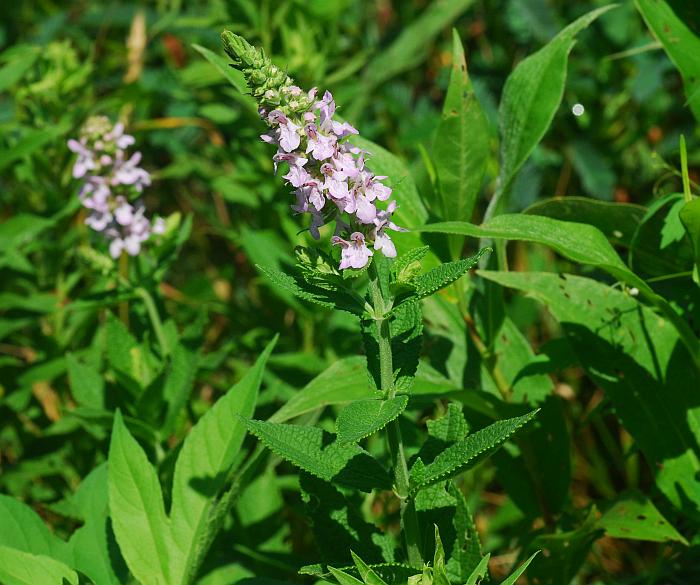Stachys pilosa Nutt.
Woundwort

Native
CC = 6
CW = -3
MOC = 33
© SRTurner
Stachys pilosa Nutt.Woundwort | |
 |
Native CC = 6 CW = -3 MOC = 33 |
© SRTurner |
|
Family - Lamiaceae Habit - Perennial herb. Stem - Stems ascending to erect, to 1 m, square in cross section, densely pubescent on both angles and sides with downward-angled to spreading and sometimes glandular hairs. Nodes often with a denser transverse line of longer, finer hairs.
Leaves - Opposite, simple, sessile or very short-petiolate, the petioles shorter than 7 mm. Leaf blades 3-10 cm long, lanceolate, elliptic, or narrowly ovate, rounded or sometimes shallowly cordate at the base, sharply pointed, the surfaces moderately pubescent and usually rugose, the margins with closely-spaced teeth.
Inflorescences - Terminal, interrupted or loosely continuous spikes, with flowers typically in small discrete clusters. Bracts similar to foliage leaves but much reduced.
Calyces - Actinomorphic, 6-10 mm long, narrowly bell shaped, 5-lobed, the lobes triangular, pubescent, the hairs often gland-tipped.
Corollas - Strongly zygomorphic, 12-15 mm long, typically light pink, the lower lip usually with reddish-purple markings, the outer surface pubescent with short, gland-tipped hairs, the tube funnelform, deeply 2-lipped, the lobes slightly shorter than the tube, the upper lip usually slightly shorter than the lower lip, the lower lip 3-lobed with a large central lobe and 2 small lateral lobes. Stamens 4, not exserted, all ascending under the upper corolla lip. Ovary deeply lobed, the style appearing nearly basal from a deep apical notch. Style exserted, more or less equally 2-branched at the tip.
Fruits - Dry schizocarps, separating into 4 obovoid nutlets, these 1.5-2.5 mm long, rounded at the tip, somewhat 3-angled, the surface dark brown to nearly black, glabrous, finely pebbled or irregular.
Flowering - June - September. Habitat - Bottomland forests, swamps, streambanks, sloughs, marshes, fens. Origin - Native to the U.S. Lookalikes - Other species of Stachys. Other info. - This plant is found in scattered locations mostly in the northern and eastern sections of the state. It is widely distributed in the U.S. but absent from some southeastern states. It is characterized by stems which are hairy on both the surfaces and angles. The upper leaf surfaces are also conspicuously rugose. Plants in the Stachy genus could be confused with Teucrium, as the gross appearance is similar. However, Teucrium canadense (the only Missouri representative of that genus) lacks an upper corolla lip. A common mnemonic for this distinction is "Teucrium is topless." Photographs taken at Marais Temps Clair Conservation Area, St. Charles County, MO, 7-22-2013, 7-5-2020, and 7-28-2020 (SRTurner). |